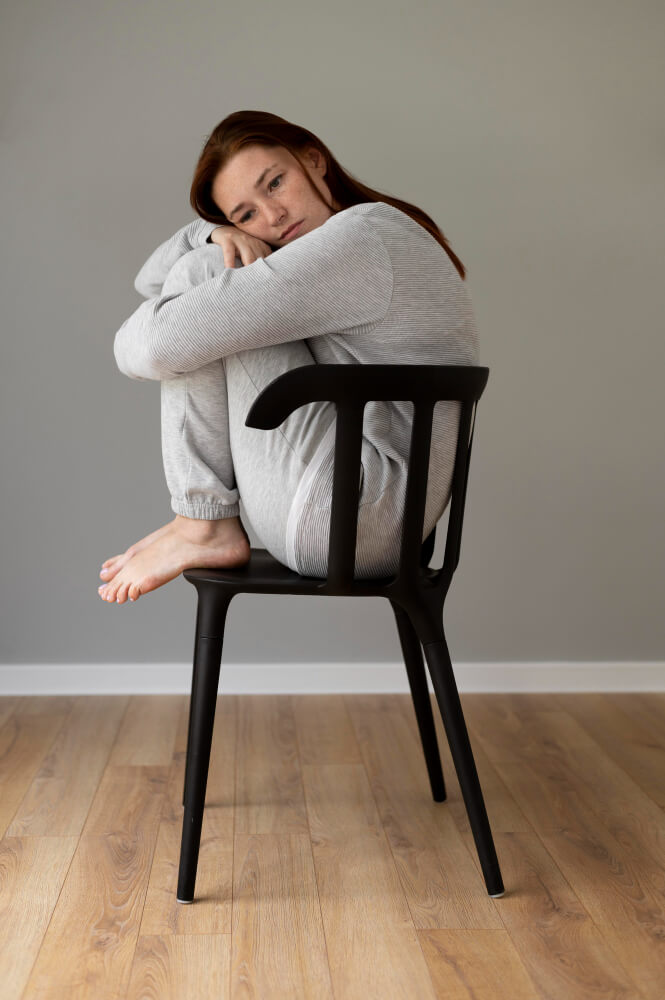Introduction to Mental Health in Females
Mental health in females is a critical but often neglected part of one’s whole well-being. These special psychological issues in females are innately hooked with biological, hormonal, and sociological influences. Ever wondered why women are more vulnerable to certain mental disorders than men? Well, it is not all about genes; it is how life experiences, hormonal changes, and societal expectations combine to give a shape to the mental health landscape.
Consider the quiet battles that so many women fight: steady anxiety, depression, or the crippling outcome of stress. These are not feelings that pass; rather, they very often are harbingers of latent mental disorders that ask for attention. Depression, anxiety, PTSD, and eating disorders are just some of the illnesses that afflict women disproportionately. Because of this, it behooves us to learn how these diseases manifest themselves differently in women compared with men.
What if knowing the labyrinth of a female mind could be the key to supportive care and recovery? Just think about being equipped with the appropriate knowledge to recognize the symptoms of disorders on time, long before they do serious damage to a person’s life. As we explore unique mental health challenges for women, we are breaking the stigma that has built around these conditions, facilitating early intervention, and creating environments that support women.

Are you ready to go even deeper into the world of female mental health, to expose those hidden dynamics creating such challenges? It’s about time for action. Awareness is always the first step toward any meaningful change. Let’s begin with understanding the basic differences that make women’s mental health both intricate and so important.
The Importance of Addressing Mental Health in Women
More than a public health concern, women’s mental health is a social imperative. Worldwide, untold numbers of women are fighting silently with mental disorders-tubbed under the rug of societal expectations or misattributed to emotional ups and downs. But let us set the record straight: the mental health struggles of women are singular, shaped by fluctuations in their hormones, life events, and ethnic demands. Why should this matter to you? Besides, neglecting these differences might give disastrous results not only for the individuals themselves but also to families and the whole community.
Imagine a world in which women receive the support they need, one in which early intervention into mental disorders can stop a lifetime of suffering. These are not issues purely about treatment; they’re about prevention, women’s empowerment, and supportive environments not being oppressive toward them. Approaches toward emotional well-being begin with recognition of unique stresses women bear. Now is a time when mental health in women needs to be taken seriously, barriers to their care torn down, and struggles not passed by or minimized.
We all ought to act now. Less ignorance, fewer complications today mean healthier, stronger women tomorrow.
How Mental Disorders Affect Women Differently Than Men
While mental disorders are a general problem in humankind, the way they manifest themselves in women and men does differ profoundly. Much of the research and treatment options historically relate to men; thus, there is a lack of understanding when it comes to female-specific experiences with mental health. Although women are more likely to experience depression, anxiety, and post-traumatic stress disorder, all these same mental disorders show their signs and symptoms differently in females, which complicates diagnostics and appropriate treatment.
The agitation? From hormonal fluctuations throughout menstruation, pregnancy, and menopause to the added societal expectations-the list just goes on. These factors not only enhance their vulnerability to mental disorders but also accentuate their symptoms. The majority of the women keep quiet, fighting through different roles-played as a caregiver, professional, and partner-while their silent mental health deteriorates further. Traditional models of treatment utterly fail to take these subtleties into consideration and leave many women feeling misunderstood and unsupported.
The solution has been to redefine the approach toward mental health in women-keeping in view the gender-specific methods where the presentation of a mental disorder occurs, hence making treatments more attuned to their needs. Whether it is adjusting therapy to hormonal changes or further sensitive support systems because of gender differences, the approach will make the treatments for mental health a lot more effective. It is about time the gap is bridged and recognition and care are provided to the females.
Depression: The Leading Mental Health Challenge for Women
Depression is not just a fleeting sadness; it is a pervasive and insidious mental disorder that afflicts millions of women worldwide. In fact, it stands as the leading mental health challenge for females, with statistics revealing that women are nearly twice as likely to experience depression compared to their male counterparts. Why is this the case? Hormonal fluctuations, societal pressures, and unique life experiences converge, creating a perfect storm for emotional turmoil.
This sobering reality should capture attention. Women often face the dual burdens of career demands and familial responsibilities, all while wrestling with internal struggles that remain hidden beneath a façade of normalcy. The interest lies in understanding how these factors contribute to the prevalence of depression and the urgent need for a paradigm shift in how society perceives and addresses these issues.
There is a compelling desire to foster awareness and empathy surrounding this pervasive condition. Women must feel empowered to seek help and support without stigma. Addressing depression means recognizing it as a significant public health concern that warrants immediate attention.
Action is imperative. Communities must rally to create resources that not only support mental health initiatives but also promote open dialogues around depression and other mental disorders. By prioritizing women’s mental health, society can cultivate an environment where women can thrive, unburdened by the weight of unaddressed emotional challenges. It’s time to break the silence and reclaim the narrative surrounding women’s mental health.
Understanding the Unique Causes of Depression in Females
Depression is not just a mood; it’s a serious mental disorder that can affect the very core of a woman’s being. To many women, depression is apparently different from what men go through, and it often emanates from a complex interplay between biological, psychological, and social factors. Ever wondered what really lies beneath this widespread phenomenon? Precise comprehension of the specific roots of depression among females is crucial for intervention and support.
Attention is drawn to the alarming statistics: Women are nearly twice as likely to be depressed as their male counterparts. These shocking facts raise many questions about the numerous causes of these statistics. The changes in one’s hormones-from puberty to pregnancy to menopause-can greatly contribute to the cause of depressive states. Add that to societal pressures-beautiful bodiesto caregiving and career success-and one can easily see it becoming more and more complex.
In this regard, deeper insights are necessary to help with empowering the women and their families. The unwinding of unique causes will actually create an empathetic environment-one that encourages understanding. It is not symptom identification; rather, it is actually dealing with the root cause contributing to these mental disorders.
We need action. We want professionals in mental health, families, and communities banding together, developing strategies tailored for the experiences that women have. As we continue with research and support that zeros in on a woman’s particular experiences of depression, let us begin to break this stigma and lead the way toward true healing. We need to open up communication and shed light on pathways to mental health everywhere that a woman is found.
Hormonal Factors: The Role of PMS, Pregnancy, and Menopause
It is not only a biological change but can even affect the mental health of women and give birth to a host of psychological disorders. From PMS, pregnancy, and menopause, this wheel of life unlocks barrage after barrage of hormonal changes that may affect mood, energy level, and emotional stability. Have you ever experienced those mood swings that usually accompany these stages? Understanding such deep-rooted hormonal factors goes a great deal in explaining some of the special mental health challenges women face.
Attention is drawn to the fact that these phases are more in relation to susceptibility to conditions like anxiety and depression. Most women, when suffering from PMS, mainly complain of increased irritability and sadness, serving as an introductory signal to emotional chaos. Though pregnancy is a very joyful phase in life, it at times gives way to conditions of postpartum depression due to sudden change in hormones. Then comes the stage of menopause wherein similar challenges pertaining to mood swings and emotional ups and downs are felt.
Above all, awareness and understanding of such issues are required. Only when one acknowledges how hormonal factors affect mental disorders can women seek the necessary support and care. The time to act is now: educate, advocate, and empower women with informed strategies on how to manage these transitions in a manner that sustains mental well-being.

Anxiety Disorders: A Common Struggle for Women
Anxiety is, in fact, the most common of psychological conditions among women today. Statistics are alarming: women are twice as likely to develop anxiety as men and struggle with conditions that may be crippling and all-consuming. Imagine every day waking up and feeling a cloud over your head, which results in affiliations, work, or even self-esteem issues. This is a common struggle that is worthy of attention, given the entwinement of nuances in anxiety, unique biological, and social factors.
The interest is in unearthing what accounts for this disproportionate prevalence in women. Factors such as hormonal fluctuations, societal pressures, and life transitions play critical roles in shaping anxiety responses. Whereas women are usually at an increased risk due to the different life stages they go through, like puberty, pregnancy, and menopause, understanding such a relationship is important.
It is a deep desire that women come forward to know they are not alone in this war. Care, facilities, and empathy can bring tremendous change in their lives. What is required is action. Encouraging open conversations about anxiety and promoting mental health awareness, the society can amply help women seek help and take back their lives from the clutches of anxiety.
The Prevalence of Anxiety Disorders Among Females
Anxiety disorders have touched the lives of millions of females and have completely changed them in irreversible ways. Recent studies indicate that women have a nearly two-fold increased risk of developing anxiety disorders as compared to men, and for this reason, it is an issue very deserving of concern. Imagine waking up every day with an ongoing underpinning feeling of dread so that those minor concerns about daily life and routine become overwhelming burdens. That is how thousands of women suffer because of anxiety, and nothing underlines more suitably the requirement to understand its prevalence and impact.
What drives this disproportionate rate in women? Monitored hormonal changes, pressurized adherence to societal expectations, and some specific life events create the perfect storm for anxiety. From the challenges of balancing career and family to the pressures of navigating significant life events, women have a host of stressors that can further exacerbate these mental disorders.
There is this overwhelming urge to give light to this usually very little talked-about issue. Awareness must be spread, and open discussions will tear down the stigma that surrounds anxiety disorders. Action must be done; women must be empowered with knowledge and support so that ultimately, they will have the path to healing. It’s time that anxiety disorders affecting females be brought out into the open to advocate for the mental health services they need.
Exploring Different Types of Anxiety: Generalized Anxiety, Panic Disorder, Phobias
Anxiety disorders have touched the lives of millions of females and have completely changed them in irreversible ways. Recent studies indicate that women have a nearly two-fold increased risk of developing anxiety disorders as compared to men, and for this reason, it is an issue very deserving of concern. Imagine waking up every day with an ongoing underpinning feeling of dread so that those minor concerns about daily life and routine become overwhelming burdens. That is how thousands of women suffer because of anxiety, and nothing underlines more suitably the requirement to understand its prevalence and impact.
What drives this disproportionate rate in women? Monitored hormonal changes, pressurized adherence to societal expectations, and some specific life events create the perfect storm for anxiety. From the challenges of balancing career and family to the pressures of navigating significant life events, women have a host of stressors that can further exacerbate these mental disorders.
There is this overwhelming urge to give light to this usually very little talked-about issue. Awareness must be spread, and open discussions will tear down the stigma that surrounds anxiety disorders. Action must be done; women must be empowered with knowledge and support so that ultimately, they will have the path to healing. It’s time that anxiety disorders affecting females be brought out into the open to advocate for the mental health services they need.
Trauma and PTSD: The Hidden Mental Health Crisis
Trauma leaves an indelible mark-one that can fester beneath the surface for years, unharmed and untreated. Post-Traumatic Stress Disorder is not just a term reserved for war veterans; it is a profound, and often hidden, crisis with which millions around the world suffer. The mental and emotional scars of trauma can manifest in so many unpredicted ways in those who have suffered it and may further lead to crippling mental disorders. Imagine a life lived in alert-from which terrors of life splash into one’s consciousness without notice and are running your life, controlling your emotions, thoughts, and actions.
This is important in order to give a broader understanding of how trauma can affect PTSD, as well as daily living. From flashbacks and nightmares, to deep anxiety and depression, the impact from unresolved trauma runs much deeper than most realize. Whether caused by traumatic events from childhood, abusive relationships, or something that happened out of the blue, PTSD is often unseen and not shared, leaving many without the help they really need.
Awareness is demanded, and action is taken. The secret crisis of trauma and PTSD can be exposed in order to bring empathy, provided avenues toward help for the ones affected. It’s about time to give voice to the silent struggles and concrete action toward healing and recovery of those forced by this oft-overlooked crisis.
Why Women are More Prone to Developing PTSD
It beg[ii]s urgent questions of vulnerability and mental disorders health because the astounding statistic of women being twice as likely as men to develop PTSD. Reasons for such a difference are multi-layered but indisputably linked to specific forms of trauma that women experience. From sexual violence to domestic abuse, women face particular threats that leave lasting psychological scars. These are mental disorders, particularly PTSD, that have the strongest influence on the very foundation of life, putting the survivors into a constant state of most vivid fear and emotional turmoil.
The question of interest is fully understanding why women are most likely to be prone to it. The hormonal changes, societal pressures, and interpersonal violence make females more prone to PTSD. What are the consequences? Severe emotional misery that affects relationships, careers, and overall well-being.
This may be one of the imbalances that can be addressed through awareness and proper delivery of mental disorders health interventions among women. The time to act is now-create those safe spaces for healing and support people who have been suffering with PTSD.
The Link Between Domestic Abuse, Sexual Assault, and PTSD in Women
Domestic abuse and sexual assault are much more than physical violations; they leave indelible emotional wounds, which result in trauma that sometimes takes a lifetime to heal. For many women, these terrifying experiences form the starting point for a most destroying mental disorder, known as post-traumatic stress disorder, or simply PTSD. Victims often relive their trauma in vivid flashbacks, crippling anxiety, and a constant feeling of mortal danger from which they feel unable to escape.
What makes this connection particularly alarming is the sheer frequency with which women endure such abuses. This can be seen in simple statistics that show the disparities between the rates at which women are victims of domestic violence and sexual assault, thus explaining why PTSD rates are significantly higher among them.
Naming this connection is the first step toward breaking the silence. Shedding light on the crossroads of abuses and mental disorders creates significant change. Now comes the next step: to act. Ensure survivors receive much-needed psychological support to heal and reclaim their lives.
Eating Disorders: The Silent Struggle
Eating disorders are not about struggling with food; this is often an invisible suffering whereby millions of people are afflicted. Concealed below the surface, a slow battle takes over: one’s mind, distorted body image, and a vicious cycle of self-doubt, guilt, and shame that forms. The struggles of many are hidden deep and get worse with pressures of society for perfection.
What makes eating disorders particularly dangerous is their silence. They don’t make any loud announcement of arrival but, instead, they creep in and make their silent attacks on both physical health and mental disorders well-being. The turmoil, isolation, and endless internal conflict create a distant dream of recovery.
It’s great to understand and create awareness regarding this silent struggle. The hour has come to break this silence, inspire conversations, and support those in need. It is only by being frank about eating disorders that there can be more empathy towards mental disorders illness-is what helps to push along those affected in seeking the help they ought to have.
The Most Common Eating Disorders in Females: Anorexia, Bulimia, and Binge Eating
Eating disorders remain some of the most widespread mental disorders health issues that women face, with anorexia, bulimia, and binge eating disorder taking the lead. These disorders don’t just change eating patterns but take hostage a woman’s self-concept, mental disorders health, and physical well-being. Anorexia brings an unrelenting obsession with thinness that presses an individual into extreme food restriction, while bulimia entails a destructive cycle of bingeing and purging that devastates both mind and body. It is binge eating, often underacknowledged, which traps women in vicious circles of emotional overeating that produce guilt and despair.
Their effects far transcend food. To so many women, the struggle day after day against their reflection in the mirror, and against society’s expectations, feels insurmountable. That better understanding and dealing with these issues are not only about diet but about mental disorders survival, the longing to recover, though painfully hard, is not impossible. We can only bring awareness and initiate free discussions that would lead the sufferers toward healing by pointing out the prevalence and impact of anorexia, bulimia, and binge eating. The time is now for us to act and to provide women with support and resources to overcome these secret battles.
Societal Pressure, Body Image, and Their Role in Eating Disorders
The societal pressures of living in a world where perfection is flaunted on screens and social media feeds can be overwhelming, especially with increased pressure on women. The pursuit of this unreachable perfect body image has disturbingly led to an increase in mental disorders such as eating disorders. Every day, women are bombarded with images idolizing slenderness that reinforce feelings of inadequacy. The result? An insidious cycle of self-doubt, extreme dieting, and disordered eating that seriously impairs health, both physical and mental.
All but the blind will see that body image and eating disorders are related. For many women, the chase for perfection means constantly being told by society how they must look, eat, or generally behave. The pressure does not only mutilate self-esteem but also drives many into dangerous behaviors that spiral into anorexia, bulimia, or binge eating.
The need for change is indispensable. Let us acknowledge the effect of such pressures and body positivity to dismantle horrific ideals and help women love their bodies. It’s time now for the very loud revolution: promoting a healthy mindset and creating an environment where true beauty is not measured in size, but self-acceptance.
Other Significant Mental Health Conditions in Women
Women face some unique challenges with mental disorders health. Other than depression and anxiety, other mental disorders seriously affect a woman’s being. Other less-recognizable disorders are postpartum depression, borderline personality disorder, and premenstrual dysphoric disorder, which usually go unnoticed or misdiagnosed. These are capable of causing severe emotional and psychological distress and can affect not just the individual but also families and society.
Interest is how these mental disorders manifest uniquely in females. The hormonal fluctuations, the societal expectations entailing, and even traumas are taking a critical role in triggering or worsening symptoms. These conditions, when faced by women, come with mood swings, overwhelming sadness, or emotional instability, though many times they may not understand the root cause.
The call for awareness, coupled with reaching targeted care, is of prime importance. Such conditions require focused attention and facilities in order for women to be suitably treated. Now is the time to act-advocating for better research, treatment, and support systems that could steer women through their difficulties in successfully dealing with their mental disorders health challenges.
Bipolar Disorder: How It Affects Females Differently
It is no fun being bipolar, and things can get a little more convoluted when it has to do with women. Fast come the shifts between manic highs and depressive lows, not only exhausting but tend to be more frequent in females. These mood swings can be unpredictable and may leave women having to struggle with feelings that can derail their personal and professional lives.
What makes this even more compelling is how the element of hormones really comes into play, even in the triggering of episodes. It is known that pregnancy and menopause tend to exacerbate symptoms because of fluctuating hormones. Would this imply that the management of mental disorders, such as bipolar disorder, uniquely presents quite a challenge to women? Just imagine having to live in a continuum of highs and lows, wherein even just a slight hormonal shift can drive a person into either a manic episode or deep depression.
These subtleties are important to learn. For women, treatment plans need to be different and must address the psychological and biological components of the problem. By highlighting differences in how bipolar disorder manifests in females, we can develop more successful strategies to help women recover and live productive, satisfying lives.
Conclusion
Bipolar disorder unfortunately predisposes women to be so vulnerable because of the interplay of hormonal fluctuations and mental disorders health. It also proves beneficial to identify those changes that may further help disorganize moods and emotions to ensure that appropriate and sensitive treatment is accorded to them. In essence, personalized treatment has to target both the psychological and biological aspects to enable these females to better handle their mental disorders, increasing their quality of life in general. It is bringing forth these sets of differences that form the first step toward ascertaining that women receive comprehensive support to ensure long-term stability and recovery.
Why Women’s Mental Health Deserves More Attention
While the discussion about mental disorders has evolved and changed in today’s society, women’s mental health often gets left behind. The lack of awareness is amazingly dangerous. Considering the hormonal changes they undergo up to societal demands, women have to go through a few experiences that might result in mental disorders. Picture living your life where the turmoil inside of you gets doubled by the stigma associated with mental disorders health, forcing many to suffer in silence. Women’s mental health requires an extra special kind of attention. Surveys show that women are more diagnosed with anxiety, depression, and some other mental health disorder than men, not infrequently exacerbated by trauma, reproductive health concerns, and caregiving burdens. Yet, however vivid their needs for particular concern may be, it seems to play little role in most mental health resources. This calls for one to join the push for a paradigm shift in priority to be able to have access to treatments and support systems dedicatedly available to women, especially concerning their mental health. By raising this conversation a notch higher, we can build a society not only able to appreciate the presence of the mental health problems women experience but also to work at treating them. It’s now time for action-because every woman deserves a chance to blossom without bearing the sting of untreated mental health problems.
Empowering Women to Take Charge of Their Mental Health
Now, while women’s voices are finally being heard, mental disorders health should be placed center stage. Mental disorders are not mere statistics but a very real experience that several women go through daily. Picture this: a woman juggling between work, family, and societal expectations at the expense of her well-being. Such relentless pressure can lead to a myriad of mental health challenges, which include anxiety and depression. Of course, the interest in the empowerment of women to take charge of their mental health appetite lies in the realization that knowledge is transformative. Through comprehension of their mental state, women are able to identify the warning signals of mental distress and have the ability to seek whatever help is required without stigma. A desire for change is palpable. Through self-care, therapy, and community building, women can reclaim their stories. It is now time to tear down barriers in seeking mental health support. It is now time to take action. Strengthening the call to women to protect their own mental health not only secures the well-being of individuals but also builds resilience within families and society. And we should make sure this becomes a culture wherein each woman can be so empowered to take good care of her mental health and feel satisfied in every sphere of her life.
Here are five external resources that provide valuable information on empowering women to take charge of their mental disorders health:







